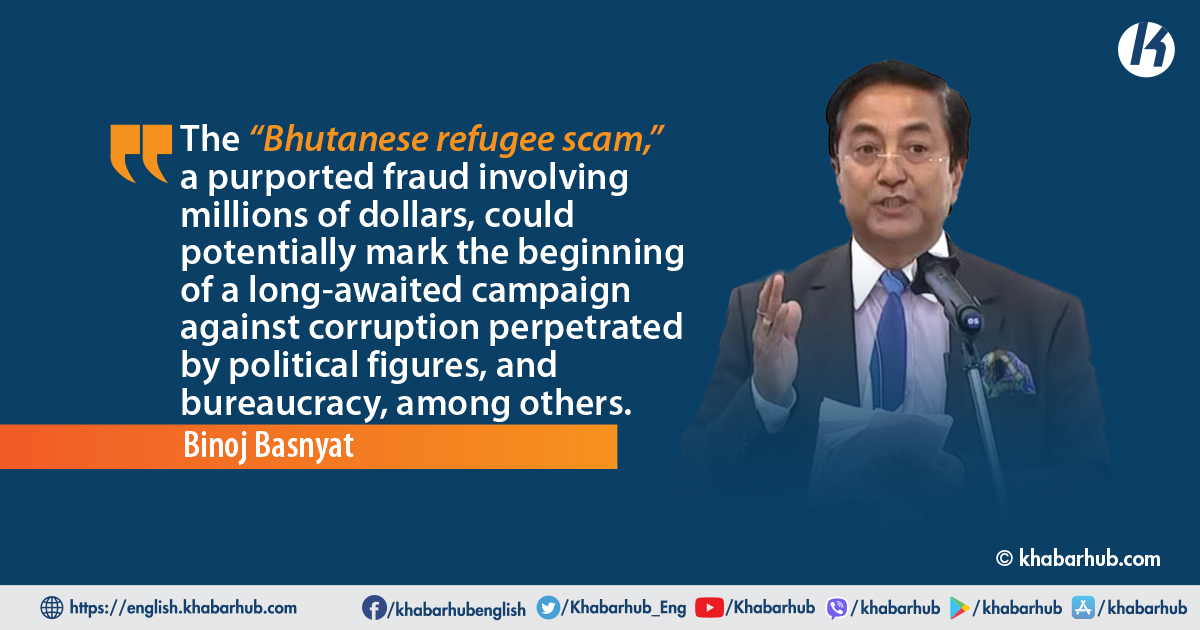The WION News channel from New Delhi headquarters said on 3 May “Nepal’s economy has plunged into recession for the first time in 60 years.
The country, on Tuesday, put a forecast at its economic growth rate-this fiscal year would be only 2.16%.
However, the forecast from Nepal’s national statistical office is lower than the projections of the institutions such as the World Bank (WB) and the Asian Development Bank (ADB).”
Is it politics or how far is this true and what do you learn from other recent financial crises is an argument in South Asia and the largest economy the US.
Furthermore, Nepal is authenticating the fake Bhutanese refugee scam that is questing the conviction of donors and international agencies.
It has downgraded the confidence of the general people as well as raised an argument of national security and national credibility of the politicized institutions and the political system.
As per the Public Department Management Office (PDMO) South Asian countries owes 87.89 percent of their foreign debt to multilateral donors like the WB, ADB and bilateral donors.
US$3.94 billion (NPR471.17 billion comes from the WB under International Development Association, an international financial institution.
The COVID-19 crisis has had significant implications in the world and South Asia. Together with it rolled the financial crisis in Sri Lanka. Pakistan followed suit.
The financial crisis is not just about economic policies but also about political decisions, structural performances, corruption, mismanagement and unaccountability.
Pakistan got a one billion US dollar bail with conditions for the 2022-2023 economic crisis.
The second factor is the high inflation after the floods that caused extensive damage to agricultural lands, livestock, damaged communications networks and infrastructures.
The US also witnessed the bank crisis. Sri Lanka witnessed social disorder and even difficulties in political adjustments to find a solution due to political decisions, political performances and national economic policies.
But, will political unaccountability, the institutionalization of political corruption and the politicization of structures and institutions, in Nepal going to be another victim?
US economic instability and Political assurances
The US got back to its consistent financial arrangements with the personal intervention of President Biden with his national economic council and aides but importantly assured the people of their safe deposits, access, and the returns of all their money.
However, analysts still expect to fall into economic recession sometime this year with a mix of higher interest rates to between 5 and 5.25 percent 10th hike from nearly zero last March 2022 and making it expensive with rising prices.
The policies were straightened right to protect workers, small businesses, and tax papers and promised to “hold those responsible for the mess fully accountable”.
Biden said, “The American people and American businesses can have confidence that their bank deposits will be there when they need them.”
It was to reassure the depositors at the Silicon and Signature Banks collapse has nothing to do with the national economic instability and conditions but more to the disinformation and the fear of losing their assets.
US authorities came forth with emergency measures to shore up the banking system.
The European Bank has also raised rates again with smaller amounts.
What went wrong in Pakistan?
Pakistan a lower middle-income nation, with half of its population under the age of 22, 23rd largest in terms of GDP based on Purchasing Power Parity (PPP) stands at US$ 6,662 (168th) is a member of the Economic Cooperation Organisation, South Asia Free Trade Agreement, International Monetary Fund (IMF), World Trade Organisation, Asian Infrastructure Investment Bank, ADB, and Other trade organizations.
The nominal GDP stands at US$ 376 billion with a nominal GDP per capita of US$ 1,658 (177th) as of the fiscal year 2022, the lowest in its neighborhood except war-torn Afghanistan.
The unemployment and inflation rate is running at over 30 percent, a 50-year high in addition food security is at the edge with one-third of the poor population to be looked after.
Health, knowledge and standard of living, the basis of the Human Development Index place in the 161st position out of 185 in 2022.
Comparatively, the manufactured exports in 1960 were higher than those of the Southeast Asian countries with an average annual real GDP growth rate was 6.5 percent.
Launched its first digital communication satellite Badr-1 in 1990, and a successful nuclear test in May 1998.
The first bailout of 1958 was also due to the dependence on imports and an unpredictable political unpredictability and national economic policies.
Pakistan’s economic crisis 2022-2023 is ongoing. Pakistan has pulled together liberalization including privatisation of all government corporations.
Policies that are aimed at attracting foreign investments and decreasing budget deficits.
In June 2022, inflation was at an all-time high with a decline in the value of the currency leading to disappointment to repay foreign debt, the rise of food, gas and oil prices, leading to depreciation of currency with increasing possibility of default through Ukrainian crisis is one factor with the rise in fuel prices worldwide.
The second factor is the high inflation after the floods that caused extensive damage to agricultural lands, livestock, damaged communications networks and infrastructures.
Higher tariffs with every import of much-needed oil import are another factor.
Multiple reasons, but was too poor governance, poor economic management, corruption and excessive spending on defense and armed forces, and low productivity per capita in comparison with other low to middle-income developing countries has resulted in a balance of payment crises, whereby the country was unable to earn enough foreign exchange to fund the imports that it consumes.
Though the economy began to privatize as a semi-industrial economy in late 1990 with dependence on agriculture and textile industries, political nationalism has had influences on financial services, manufacturing, and transportation from the 1970s.
The third source is excessive external borrowings over the years based on private industries’ raised spectra of default, causing the currency to fall and making imports more expensive in relative terms.
30 percent of the external debt and liabilities while refinancing and a rollover of deferring debt repayment with high interest are owned by China.
Thus far, Pakistan continues to be one of the hugest recipients of Chinese loans with infrastructure development through China Pakistan Economic Corridor (CPEC) as well as defense acquisition.
However, the country continues to face the challenges of a rapidly growing population, high illiteracy, corruption, political instability, a hostile neighborhood and heavy foreign debt. Falling low on budgets for paying interest on its debt.
The economic crisis was at the center of the political standoff between Prime Minister Shahbaz Sharif and Imran Khan in 2022, which led to Khan’s ouster in April 2022.
Pakistan received one billion in bail to help solve the financial crisis, which is the twenty-third time in the last five decades from the IMF.
The political appeals with tax cuts that reduced government revenues, forbidding chemical fertilizers imports without preparing the farmers which impelled a surge in food prices, continuing of a favorable monetary policy beyond its shelf life and persisting with fixed exchange rate without the foreign reserves to support it were other misinterpretation of governance.
The first bailout of 1958 was also due to the dependence on imports and an unpredictable political unpredictability and national economic policies.
The Statista Aaron O’Neil predicts that the national debt of Pakistan will continuously increase between 2022 and 2027 by a total of US$ 126 billion.
The national debt is estimated to amount to US$ 363.88 billion in 2027.
The footprints of economic patterns progressing on foreign loans only lead to borrowing; sooner or later moving into bankruptcy.
According to the IMF regional economic outlook, the total external debt is more than US$ 41 billion in 2023.
More than 40 percent of the national GDP. It has to return US$ 80 billion in foreign debt over the next three and half years until June 2026.
Data from the State Bank of Pakistan (SBP) suggests that Pakistan is to repay a total debt of $21.95 billion in one year; $19.34 billion in principal and another $2.60 billion in interest on the total debt.
According to data, however, the central bank has projected no foreign debt inflows for the next 12 months.
Sri Lanka and the Economic Crisis
Sri Lanka was set back decades of advances in per capita incomes and reduction of poverty with the worst economic crisis since independence in 1948.
It was indicated from 2019 leading to unprecedented levels of inflation, near depletion of foreign exchange reserves, shortage of medical supplies and inflation of basic commodities in a country with records of success stories in the developing world for meeting basic human needs.
It is both economic and political consequences. Besides the President and the Prime Minister, all of the cabinets resigned following the mass public protest over the rising cost of living and economic management on 6 April 2022.
Sri Lanka in an anticipatory act postponed foreign debt reimbursements awaiting a bailout from the IMF on 12 April 2022, which then provoked international ratings agencies to reduce to restrictive or selective default.
The public debt to GDP rose from 91 percent to 119 percent between 2018 and 2021with external debt service payments of US$ 6 billion for the remainder of 2022 against foreign reserves of US$ 1.9 billion.
The amalgamation of peripheral economic tremors and policy missteps is the source at the back of the crisis.
The economic shock from COVID-19 wedged half a million into poverty intended an economic inconsistency of 3.6 percent in 2020.
The Ukraine crisis gave upsurged fuel and food prices leading to double-digit inflation and a 30 percent depreciation of the rupee against the US dollar.
These shocks came when the economy was recuperating from the thirty-year civil war that ended in 2009.
China’s funds and technical assistance have been making significant entries into infrastructural investments, the industrialization process, human resources development, health, education, water resources, and sports but are not vulnerable to overall external debts.
There was a continuation of monetary and current account deficits, unwarranted foreign borrowing for low-return infrastructure projects and rising external debt service.
The political appeals with tax cuts that reduced government revenues, forbidding chemical fertilizers imports without preparing the farmers which impelled a surge in food prices, continuing of a favorable monetary policy beyond its shelf life and persisting with fixed exchange rate without the foreign reserves to support it were other misinterpretation of governance.
China the source of FDI is also uttered of the US$ 8 billion in debt with high interest rates which culminated from 2005 to 2015. It is a geostrategic interest in the maritime domain. Preoccupied to repay the loans, Hambantota Port was leased for 99 years as of 2017.
Analysing Nepal’s Economy
Mixed feelings are drifting. Influential political leaders have been stating that the economy is not performing as it should have for various reasons even when there is a rise in remittance and tourism that acquires almost 28 percent and 7 percent respectively of the national GDP.
Besides India, approximately 3.5 million Nepalese (14% of the total population) migrated for foreign employment.
Agriculture remains the principal economic activity employing 65 percent of the population and providing 31.7 percent while remittances are more than 22 percent (9.1 percent of the 9 million working force) of the GDP.
The revenue collection is not as expected and not enough to meet the recurrent expenditure. The inflation rate is at 7.4 percent year-on-year basis.
Half of the development budget is from foreign aid amounting to over NPR 138.5 billion though had set a target to receive NPR 242.26 billion and foreign grants of NPR 44.46 billion of which NPR 24.56 billion as grants and NPR 114 billion in foreign loans from different bilateral and multilateral development partners in the last eight months or as of mid-March fiscal year 2022/23.
Against the target, the commitment for foreign loans and grants stood at 47 percent and 44.28 percent, respectively. The PDMO says that the debt can be sustained up to 53 percent of the GDP.
The private sector’s contribution to the country’s gross domestic product is 81 percent, and it accounts for 85 percent of the jobs.
Japan is the largest contributor to 20 percent and also is the creditor with a share of 4.41 percent followed by China and India. Four Nordic countries, Denmark, Norway, Sweden and Finland follow.
China and India have over the past 15 years emerged as the most important bilateral donors.
China is also come up as the largest creditor. With foreign debt growing from 2.66 percent in 2017-18 to 3.10 percent in 2018-19 percent 3.24 percent in 2019-20 and 3,39 percent in 2020-21.
ADB provides 31.36 percent of Nepal’s total foreign debt of US$2.45 billion (NPR292.91 billion)
Pokhara International Airport was built with a US$ 215 million Exim Bank loan of 2 percent with a payback in 13 years with 26 installments.
Comparably 0.25 and 0.75 of the World Bank and Asian Development Bank with a payback in 40 odd-year challenging that loan pattern against grants for development.
This is an indication of a few strategic issues. One, change of government is a basis for more loans with undesirable development efforts, second unaccountability to the position being held by politicians, thirds is an attempt for corruption while in chair fourth, untapped financial interactions from diverse routes and channels.
China’s funds and technical assistance have been making significant entries into infrastructural investments, the industrialization process, human resources development, health, education, water resources, and sports but are not vulnerable to overall external debts.
Nepal’s external debt reached US$ 8.7 billion in Sep 2022, compared with US$8.8 billion in the previous quarter.
It was at an all-time high of US$8.9 billion in March 2022 and a record low of US$3.5 billion as of 2013.
Dept stood at 40.53 percent as of the second quarter of the current fiscal year 2012-22 in relation to 25.65 percent in the fiscal year 2015-16.
During the Maoist insurgency in 2001-02, the debt reached 63.9 percent, which was very discouraging.
Currently, it is 61 on the list of debt to GDP and 26 in debt per capita, out of the 190.
The placement, as compared with the rest of the world, has worsened in 2021 in terms of GDP percentage.
The projection of 8 percent reviewed to 7 percent growth opened through the scuffle between the Rastra Bank Governor Maha Prasad Adhikari and the finance minister Janardan Sharma by way of a political blame game, which was then challenged by economists.
Firstly, trade growth plunged, transportation saw a negative growth rate, and the growth rate of accommodation and food services dropped.
The construction sector the largest economic activity with the rise of building materials was negative comparatively.
Secondly, the loan provided to the construction sector declined due to a lack of funds and high-interest rates.
At the same time, the government is unable to pay NPR 125 billion for various contracts.
Third is the temporary closure of illegal crusher factories in Jan 2023 led to shortages of construction materials.
Other like pensions to 18,000 retired teachers have not been distributed, revenue dropped from NPR800.51 billion last year to NPR693.75 billion as of April in addition revenue collection reached NPR285 billion well below the target of NPR490 billion.
Uncertainty seems to be looming the main cause is the political instability has added to the economic woes foreign direct investment (FDI) too dropped to a new low.
According to Nepal Rastra Bank, Nepal received foreign direct investment totaling NPR1.17 billion in the first eight months of the current fiscal year, a steep plunge from the Rs16.30 billion in the same period of the last fiscal year.
A key indicator of an improved economy is the job market. But statistics show that Nepal has issued labor permits to 544,320 individuals to work abroad, and the country could see a record exodus of youths this fiscal year, excluding students and those going to India.
In April, the Statista forecasted that the national debt of Nepal will increase between 2023 and 2028 by in total US$ 15.3 billion with a national debt estimated to amount to US$ 35.26 billion in 2028.
This is a 48.76 percent national debt to GDP (approximately NPR 4.85162 trillion) ratio in 2024 from 44.05 percent in 2021.
Public debt is on the rise with less tax revenues and unwanted infrastructure construction.
By mid-February of FY 2022-23, the debt liability reached more than NRs two trillion an increase of about NPR 32 billion in the last seven months since June 2022 and doubled in the last five years.
When the mindset and publicity of a recession are moving around, a statistician at the National Account Statistics Division said, “The country was in recession until the first half of the current fiscal year. This is probably the first time since Nepal started keeping records in 1959. But the third quarter growth looks positive.”
The internal debt is NPR 996 billion and the foreign debt of NPR 1.0473 trillion.
The data is categorized under World Trend Plus’s Global Economic Monitor estimates total loans at US$ 32.956 billion in Jan 2023 an increase of US$ 32.424 billion for Dec 2022.
It was at an all-time high of US$ 43.890 billion in Jan 2022 and a time-low of 1.767 billion in Feb 2001.
This is an indication of a few strategic issues. One, change of government is a basis for more loans with undesirable development efforts, second unaccountability to the position being held by politicians, thirds is an attempt for corruption while in chair fourth, untapped financial interactions from diverse routes and channels.
Lastly, consideration of foreign and domestic loans as major sources of budget.
In Feb PM Prachanda said that the government was alert to the crisis seen in the country’s economy and on track through a public-private partnership.
“We are advancing towards creating a favorable environment for investment and trade for the private sector by resolving the challenges seen in the economy. Two months have not passed (after the election to the PM) but positive signs are visible in the economy”.
While the speculation about the economic crisis is ongoing, the signs of lessoning of the balance of payment to NPR133.21 billion compared to the NPR247.03 billion deficit last year is visible.
The Foreign Exchange Reserves have increased by 13.8 percent in rupees and 10.2 percent in US$.
Nepal Remittance Economic Report has expressed increased inflow by 27.1 percent to NPR689.88 billion or US$5.30 billion which is 16.4 percent.
The IMF review acknowledges strong recovery with some key areas to focus on.
The other side is the Nepali character of offhand with loans without a payback system.
Political instability, the institutionalization of corruption and unaccountability is the source of economic incapability.
Media and analysts come up with overstated arguments. Development is of priority and grant-based with structured planning is the stride.
Assistance falls into three categories; grants, interest-free loans and concessional loans.
Conclusion
But the commonalities in South Asian nations are political nuisances of rulers, absence of national foreign policy, non-attendance of the national economic plan and the political approval to meritocracy, honesty and realism.
There is no universally accepted definition of a recession, but it is when there is a significant decline in economic activities spread across the economy and can last from a few months to more than a year.
There is an opportunity for the nation and may not be for the rulers set about in the corruption cases on the fake Bhutanese refugee.
When the mindset and publicity of a recession are moving around, a statistician at the National Account Statistics Division said, “The country was in recession until the first half of the current fiscal year. This is probably the first time since Nepal started keeping records in 1959. But the third quarter growth looks positive.”
As Nepal continues to be vulnerable as well as weighed down by corruption, inflation, political instability, strides to shift to middle-income status in the next three years and ill governance, the challenge to establish an independent authority is being insisted.
Transparent government spending is the need as the Executive has been a platform to plunder monetary spending.
National strategic and geostrategic development planning and projects for productive investment with less reliance on high-interest loans and preferably grant based.
Third is less political interference and lastly need for national economic strategy and plans.
The “Bhutanese refugee scam,” a purported fraud involving millions of dollars, could potentially mark the beginning of a long-awaited campaign against corruption perpetrated by political figures, and bureaucracy, among others.
PM Prachanda was elected with his public commitment to forming a high-level commission to investigate the properties of people who held public office since 1990.
“We have also expressed our commitment in the election manifesto to probe all corruption cases since 1990. We are working to form a commission”.
There is an opportunity for the nation and may not be for the rulers set about in the corruption cases on the fake Bhutanese refugee.
Coerce is acquiring space for the leaders in the chair who are not poles apart from the once-now-convicted.
The prerequisite of the various political appointments was exploited by either financial deals or political correlations contradicting meritocracy.
The author is a Strategic Analyst, Major General (Retd) of the Nepali Army, and is associated with Rangsit University, Thailand.








Comment